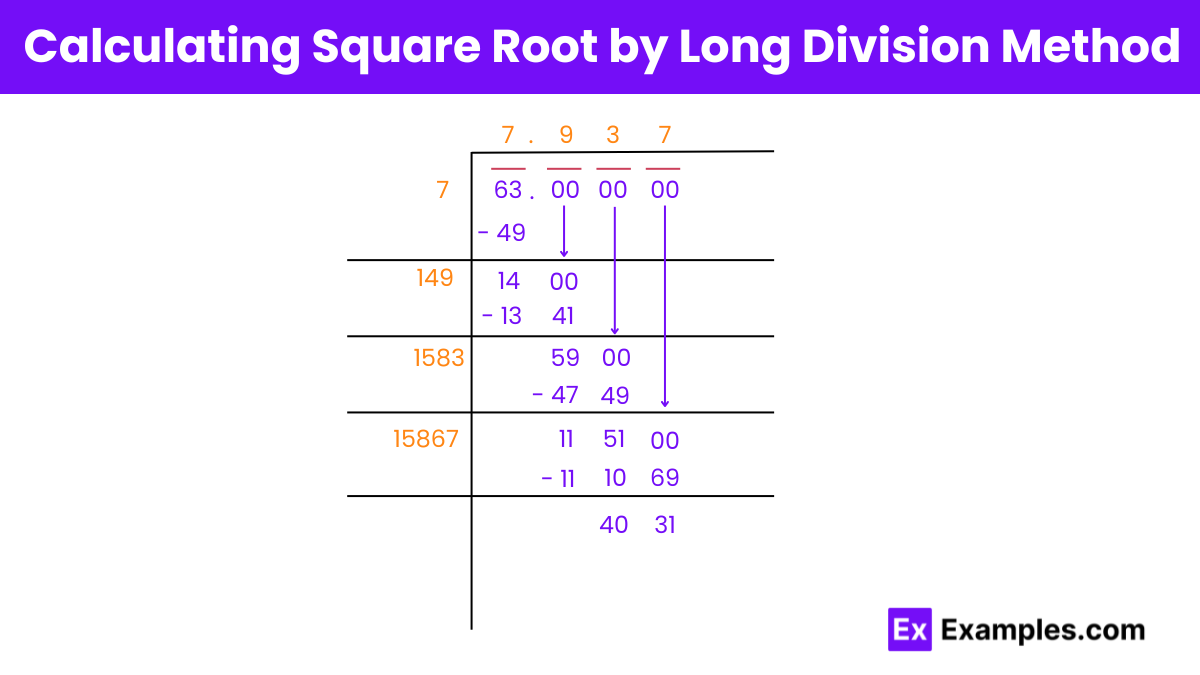What is the square of 63?
3969
3891
3961
4032


The square of 63 is 3,969. Squaring 63 entails multiplying it by itself, showcasing a fundamental mathematical operation. Understanding the properties of square numbers like 63 aids in comprehending mathematical concepts and relationships, contributing to a deeper understanding of numerical systems and their applications.
The square root of 63, an irrational number, is approximately 7.937253933193772. It represents the number that, when multiplied by itself, equals 63. Understanding square roots illuminates mathematical principles, offering insights into numerical relationships and facilitating problem-solving across various disciplines.
This is because 63 is not a perfect square, meaning there are no integers that, when multiplied by themselves, equal 63. The square root of 63 is approximately 7.937253933193772, which cannot be expressed as a simple fraction and has a non-repeating, non-terminating decimal expansion. Thus, it is classified as an irrational number.
Rational numbers can be expressed as a fraction of two integers, where the denominator is not zero.
Irrational numbers cannot be expressed as a fraction and have non-repeating, non-terminating decimal expansions.
Find the Prime Factors:
Express the Square Root:
Approximate the Value:
Set Up the Long Division:
Group the digits in pairs from the decimal point outwards. For 63, it’s simply 63.000000…
Find the Largest Integer:
Divide and Average:
Continue Refining:
Direct Calculation:
Initial Guess:
Iterative Formula:
Reference Tables:
Interpolate if Necessary:
These methods help you find the value of √63, with varying degrees of precision and computational effort.

Step 1: Pair the Digits
Step 2: Find the Initial Divisor
Step 3: Introduce Decimal Point and Zero Pairs
Step 4: Find the Next Digit
Step 5: Repeat the Process
Step 6: Determine the Next Digit
Step 7: Continue the Division
A perfect square is a number that can be expressed as the product of an integer multiplied by itself. In other words, a perfect square is the square of an integer. For example, 4, 9, 16, 25, etc., are perfect squares because they can be expressed as 2², 3², 4², 5², etc.
However, the number 63 cannot be expressed as the square of an integer. Therefore, it is not a perfect square.
The simplified form of √63 is 3√7.
A factor of 63 is any number that divides evenly into 63, such as 1, 3, 7, 9, 21, and 63.63 is not a prime factor because it can be divided by other numbers besides 1 and itself. Its prime factors are 3 and 7.
A factor of 63 is any integer that divides 63 without leaving a remainder. For example, the factors of 63 are 1, 3, 7, 9, 21, and 63.
63 is not a prime factor because it can be divided by other numbers besides 1 and itself. However, its prime factors are 3 and 7.
Text prompt
Add Tone
10 Examples of Public speaking
20 Examples of Gas lighting
What is the square of 63?
3969
3891
3961
4032
What is the square root of 3969?
62
63
64
65
Which of the following numbers is the closest to the square root of 63?
7.9
8.1
8.5
9.0
What is the approximate square root of 63 to the nearest whole number?
7
8
9
6
The square of which of the following is closest to 63?
7
8
9
10
What is the value of √63 in decimal form rounded to two decimal places?
7.94
7.87
7.90
8.05
If x² = 63, what is the value of x?
7.5
8
7.94
7
Which number squared is just above 63?
8
9
10
11
How close is the square root of 63 to 8?
Very close
Slightly less
Slightly more
Very far
What is the difference between the square of 8 and the square of 7?
15
16
17
18
Before you leave, take our quick quiz to enhance your learning!

